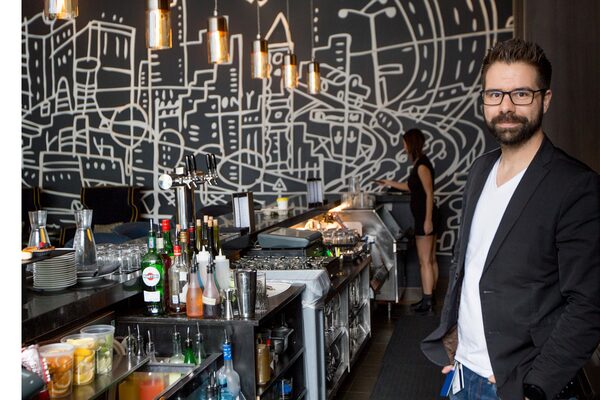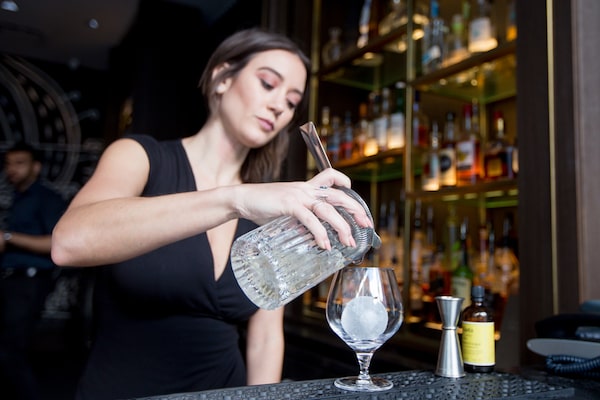
Sean Hogan, general manager of bars at the Thompson Hotel in Toronto, says the business has saved thousands of dollars per month after using the Wisk app that tracks bar inventory electronically.Salmaan Farooqui
You can use smartphone apps to streamline everything from ordering a taxi to controlling personal finance, so the head of bar services at the Thompson Hotel in Toronto wondered whether he could find one to manage his inventory of liquor.
After a few months of using a Canadian-made app called Wisk, the technology has already saved the hotel thousands of dollars by cutting down on labour costs and, by using software that predicts trends in the liquor market, it has optimized buying.
“We don’t have to spend a whole day on inventory anymore, so it’s sped things up,” said Sean Hogan, general manager of bars at the Thompson Hotel. “It took us about six or seven hours to do inventory before, and we’ve now got it down to an hour and 20 minutes.”
Wisk is one of multiple Canadian companies that have jumped into a burgeoning bar inventory app marketplace that has numerous European and American competitors. The idea is simple: The apps use a database of barcodes to identify different kinds of alcohol. They measure the exact amount of liquid left in each bottle, and suggest how much liquor a restaurant should buy based on previous sales data.
Bar inventory apps can measure exactly how much liquid is left in a bottle by using bluetooth scales to weigh them and by comparing the weight of the bottle to how much it would weigh if it were empty. Some apps can also analyze pictures of bottles to estimate how much is left in them. Altogether, it gives hotels, bars and restaurants a much better idea of their stock.
“Are there competitors? For sure, but it’s not as saturated as the point-of-sale market,” says Angelo Esposito, founder of Wisk, who says there’s still lots of opportunity for new companies to carve out a niche in the relatively new business.
“We’re lucky in the sense that if someone is using pen and paper to do inventory, they’re willing to give us a try.”
Wisk has been operating for four years now, and has been offering a service that can be easily customized for large-sized operations such as the Thompson Hotel, which has a number of bars under one roof and operates as a chain across the United States. Wisk, based in Toronto, recently landed a massive contract with Drai’s, a large nightclub on the Las Vegas strip.
Mr. Esposito said Drai’s represents a huge milestone for the company because of the sheer size – 65,000 square feet – and complexity of the massive venue, which has numerous bars within it.
There are multiple ways that bar inventory apps can save large amounts of money beyond just cutting down on labour for inventory. Wisk almost functions like a finance app by suggesting how to optimize buying, and has integrated with Ontario’s and Quebec’s liquor boards to offer direct buying through the app. It can also integrate with point-of-sale systems to identify when a bartender is over-pouring specific liquors in the process of making a cocktail.
Vinocount, a bar inventory app based in St. John’s, is working on a solution to even identify which specific employees are over-pouring certain liquors and notify bar owners when the problem is consistent.
“We’re going to pull employee time cards, compare it with the actual inventory use at any given time, and compare it with the sales system,” said Jonathan King, founder and chief executive officer of Vinocount, who said that the system can also identify if an employee is stealing alcohol. “The system will data-mine to try and establish where and why waste is happening.”

Aga Pittam, a bartender at the Thompson Hotel in Toronto, pours a drink. Eliminating over-pouring liquor in mixed drinks can add up to large savings for business owners.Salmaan Farooqui
Vinocount has been operating for 20 months now in Newfoundland, and serves about 60 clients, most of them on Canada’s East Coast. The company says it’s in the process of rolling out its service for a number of restaurants in Ontario.
The use of software in a restaurant’s inventory process makes sense compared with other kinds of businesses because of the complications of measuring a liquid asset.
“If I’m selling T-shirts it’s pretty easy. I count my T-shirts and it’s easy to measure sales,” said Mr. Esposito, who worked in the hospitality industry and as a DJ for 10 years before starting Wisk. “But when I’m selling liquid, with so many different recipes, and where one single bottle can be used in a dozen different cocktails, it becomes complex.”
And because margins are so tight in the restaurant industry, money saved from smaller issues like over-pouring liquor in mixed drinks can add up to large savings for business owners.
“Over-pour is far and away the biggest point of conversation for pretty much everyone in the industry, and margins are very tight, so keeping it under control is crucial,” Mr. King said. “On average we’re looking at between $15,000 to $20,000 in liquor savings for our clients per year.”
Those savings estimates have translated into reality for Boca Tapas Bar in St. John’s, a Spanish restaurant in the city’s downtown. Derek Locke, a managing partner of the bar, says they’ve easily saved $1,000 a month since setting up Vinocount at their restaurant.
In Vinocount’s case, liquor is only part of the equation. The company also offers a similar inventory service for food, which Mr. Locke plans to implement at his restaurant as well.
He says the app has worked considerably well for them with inventory times reduced to 30 minutes – and it’s still only in one of its earliest versions. He’s optimistic that the experience will only get better.
“Margins are everything – every 1 per cent you save comes directly to your pocket,” Mr. Locke said. “This is the type of tool that makes that 1 per cent possible.”